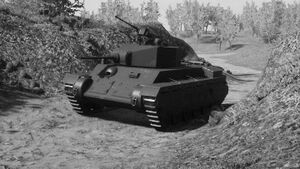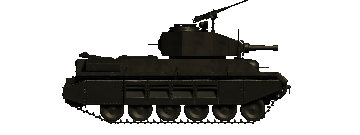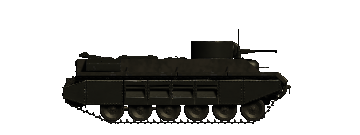RT-8 "Berggeit"
This article is incomplete because it is pending further input from participants, or it is a work-in-progress by one author. Please comment on this article's talk page to share your input, comments and questions. Note: To contribute to this article, you may need to seek help from the author(s) of this page. |
| RT-8 "Berggeit" | |
|---|---|
 An RT-8 "Berggeit" Mk IA undergoing trials. | |
| Type | Light tank |
| Place of origin | Monark van Kooplieden |
| Service history | |
| In service | 1926-TBD |
| Used by | Monark van Kooplieden |
| Wars | Anwnn Civil War |
| Production history | |
| Designer | Verhasselt |
| Designed | 1925 |
| Manufacturer | Verhasselt |
| Produced | 1925-TBD |
| Specifications (RT-8 "Berggeit" Mk IA) | |
| Weight | 12.92 tonnes (12.72 long tons; 14.24 short tons) |
| Length | 4.6 metres (15 ft) |
| Width | 2.0 metres (6.6 ft) |
| Crew | 4 (commander, gunner, driver, radio operator/bow machine gunner) |
| Armour | 30mm (front, angled 50°) 35mm (sides) 20mm (rear) |
Main armament | Royal Ordnance QF 37mm L-20 Anti-Tank Gun |
Secondary armament | 4× 7.92mm machine guns |
| Engine | Bolton Thoroughbred Mk I 16.0L V8 engine |
| Power/weight | 21.8 kilowatts (29.2 hp) / tonne |
| Suspension | Torsion bar |
| Fuel capacity | 400 litres (88 imp gal) |
Operational range | 324 kilometres (201 mi) |
| Speed | 54 km/h, 34 mph (road) 37 km/h, 23 mph (off-road) |
The RT-8 "Berggeit" (English: "mountain goat") was a successful light tank design in the Kooplieden Armed Forces' RT-series, and was developed for use in mountainous landscapes and terrain typically inaccessible to tanks. It was lightly armed and armoured, but its ease of maintenance, good manoeuvrability, high speed, and good climbing performance ensured that it would become the most common tank used by the Kooplieden Monarchy Preservation Corps in the Anwnn Civil War.
Development History
Background
When the Kooplieden Monarchy Preservation Corps was raised to participate in the Anwnn Civil War, the Corps's armoured division was lacking in tanks suitable to the mountainous terrain of Anwnn. Most of the division was equipped with the RT-6 "Vechter" Mk I, which was known for its poor performance on hills. The only vehicles in reserve that were specifically built to handle adverse terrain were the original RT-1 "Kever"'s and RGC-1 "Neushoorn"'s, which were low in numbers and severely outdated by this point. Despite these concerns, both vehicles saw combat in the first months of the Civil War, but after the
Variants
- RT-8 Mk IA
- The standard version of the RT-8, armed with a 37mm anti-tank gun. The four machine guns consist of a bow machine gun, a coaxial gun, a pintle-mounted machine gun, and a rear facing turret machine gun.
- RT-8 Mk IB
- Same as the Mk IA, but armed with a 75mm howitzer.
- RT-8 Mk IC
- Replaces the main turret for two machine gun turrets, side by side. The gunner operates the right turret, while the commander operates the left one. While weakly armed, with one less machine gun than other versions and no primary armament, the Mk IC was lighter and significantly cheaper.


